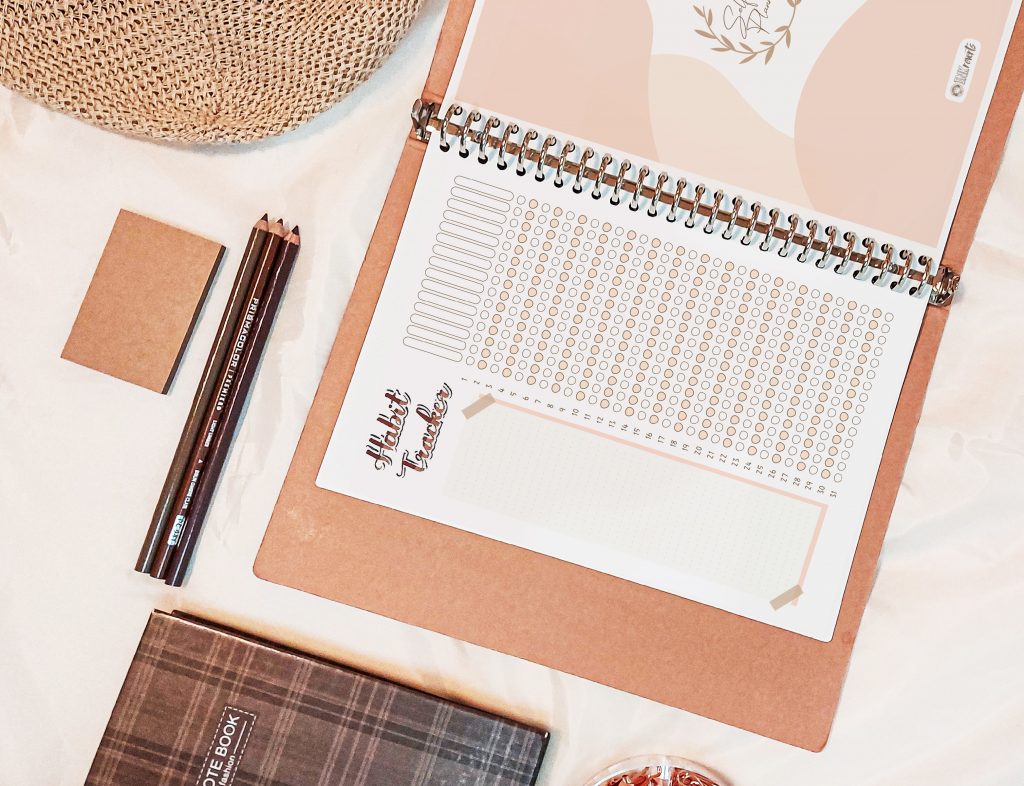

Questions is: what’s so good about bullet journaling?
2 years ago, I was obsessed with the personal growth niche. I often looked up videos and articles about how to optimize my days, increase motivation, and generally make my life more productive.
One of the repeating lines I noticed- was “bullet journaling“.
And bullet journaling doesn’t only come up when I search for productivity.
Whether it’s to develop a business strategy, or to simply reduce stress, the word “bullet jouranling” comes up.
(This post contains affiliate links.)
Table of Contents
Why should you start bullet journaling?

If you never heard of bullet journaling before, the word may give you this image:
A teenage girl is sitting on her bed, with a diary in hand.
But writing a diary is one of many forms in journaling. You write paragraphs upon paragraphs about your thoughts.
But bullet journals belongs to a sister family. Instead of writing paragraphs, you write something like this:

The purpose of bullet journaling is to organizing your mind. The content is short, simple, and straight-to-the-point.

Here are some of the benefits of bullet journaling:
To save time
You know that not all 24 hours of the day are free for you to spare.
In real life, we spend an unimaginable span of time wandering, procrastinating, and day-dreaming. All because we are not sure what next.
That’s why you can benefit greatly by planning ahead.
For example: when you wrote in the bullet journal that you’ll be doing your assignments this afternoon, you will be less tempted to do other things.
To clear your mind
In a day, your brain makes more than 30,000 decisions a day!
You brain is constantly at work. But just like your physical body, your brain power slows down as it gets tired.
The best way to avoid this is to decrease the amount of useless decisions every day.

Bullet journals remember decisions for you. As you already write down what to do on the bullet journal, you don’t have to make the effort to think about them again.
To practice your creativity

What? You may ask. What does bullet journaling have to do with creativity?
Sure, it’s primary purpose is to organize. But each journal can look different.
Using you creativity, you can design your own layouts, indicators, and color schemes.
There are many examples of creative bullet journals out there.

What to write in bullet journaling?
Alright, time to decide what to write in your bullet journals!
There are many things you can include. But you can choose those you think are useful to your daily lives.
Here are some of the most essential things:
Daily Bullet Journaling
Schedule
From 7 AM to 10 PM, when are your routines, work hours, and free time?
Having an organized schedule helps you be mindful about how much you can accomplish in one day.
Many of us tend to overestimate how much we can do in one day. Then as a result, we beat ourselves over for not managing every single thing.
Download your free daily planner here. So that you can start organizing, as well as get to know how many free hours you have in a day!

Mood
How are you feeling today?
Other than drawing a smiley face, you can also write a few lines about why you feel that mood.
It’s normal to have ups and downs throughout your life. Recording your mood in your bullet journal is helpful to be mindful of that fact.
Whenever you get sad, simply flip back to your journal entries in the past, and you will bad times don’t last.
Weather

Why should you record the weather in the bullet journal?
Good question! Weather may not have a direct relation with your to-do list.
But if you write about your thoughts and moods in your bullet journals, remembering the weather can give you a feel of traveling back to that day.
Gratitude list
Is there something about today that makes you happy? Or grateful?
I have a habit of writing 3-5 things I’m grateful for every day.
I write it in a separate journal from my regular bullet journal. But still, I didn’t need to wait long before I got a few pages filled.
Whenever life gets tough, I simply look at the gratitude list to cheer myself up.
You can even include your gratitude journaling in your daily planner.
Weekly Bullet Journaling
To-do list
You have many things to do in a week. They may be your usual routines, or some one-time thing.
To organize them, your to-do list in a weekly bullet journal is definitely useful.

I usually mark about 3 items on my list, including the part-time jobs that take hours of my day.
If I write more than 3, I’m much less likely to check everything off the list. And that’s counter-productive if I’m biting more than I can chew.
Weekly goals

I like to have a single goal for my week.
Something, like art projects, story-writing, habit-building, take more than one day to accomplish.
That’s why a weekly goal is useful: it serves to remind you about keeping up with this goal, instead of slacking off half-way through.
Self-reflection
Being self-reflective is a simple but effective habit of improving yourself.
Often, we simply live through the week without much thinking.
But in a self-reflection session, you think about what you did great this week, as well as what you can improve in the future.
Water tracker

It’s very important to stay hydrated!
A water tracker keeps you mindful about the amount of water you drink.
Do you drink enough for the whole week? Or do you drink a bit less for some days?
An average young adult has to drink about 2L of water each day. But it can vary depending on your weight and health condition.
To calculate how much water consumption is healthy for you, you can simply look up online calculators. Or visit this article here.
Monthly Bullet Journaling
Habit tracker
A habit takes more than just one week to stick. This is where monthly bullet journals are for!

The habit tracker records whether you fulfilled a habit routine each day.
If you do, check a circle! At the end of the month, you can look at the habit tracker and see how many checked circles fill your page!
Book tracker

Are you a bookworm? Then a book tracker is simply made for you!
To use the tracker, record the titles of books you read throughout your days.
You might be surprised at how many books you read at the end!
An average American reads 12 books per year- which is one book every month. Can you beat that?
Mood tracker
We talked about recording moods in your daily bullet journal, which is more in-depth about how your feel.
In a monthly log, this mood tracker give more of an overview of your mood.
For example, are you always happy this month? Or are you angry for a whole week for some reason?
Important Dates

The most basic, but essential way to do monthly bullet journaling, is to mark down important dates.
It serves pretty much like a monthly calendar. But because it’s your bullet journal, you can make your own design and tweaks!
Supplies for Bullet Journaling

Notebooks
For bullet journaling, I recommend using a blank notebook, a checkered notebook, or a dotted notebook.
You can design your own layout and what to include in these notebooks. But if you prefer to simply go ahead and write, you can also use a template.
You can download one a daily planner here.

There are many different designs of notebooks. It’s best to choose the one that fit your style, instead of getting a cheap one for the sake of saving money.
After all, a bullet journal is going to stick with you for months and even years!




Pens
You will need a practical pen for your precious bullet journal.
Ideally, you want a pen that writes smoothly, but do not bleed through the paper.
I’ve been using Uni Pin drawing pen since I was little. And this is undoubtedly my favorite pen to write bullet journals with.

Personally, I write with 0.05mm nib most of the time. Because I write very small letters. But it’s also easier to break compare to thicker nibs.
So I’d recommend 0.05mm to 0.1mm nibs to write and draw lines on your bullet journals.
Brushes
If you’re into creative lettering and calligraphy. Bullet journaling is a perfect excuse to draw them!

I use ZIG brush markers for my calligraphy. It’s a water-base marker, and doesn’t have the thinner smell you get with other markers.
It gives out a watercolor effect, but with a slightly brighter tone.


Be careful though! Brush ink is more likely to bleed through papers than pens. So make sure to try your brushes on scrap papers first before writing them on the bullet journals.
Stickers
Stickers are really popular among the creative bullet journal community.

You can choose stickers that match the color scheme of your style. And buy them from your local stationery stores, Amazon, or Etsy.
Or! You can print out images instead! Or use old book pages for a vintage style! It’s all up to you.
Tips for Bullet Journaling
Have your own style!

Do you prefer a minimalistic style? Or a vintage style? There are tons of different styles and color schemes of bullet journaling.
Just for starters, you can simply look up #bulletjournal on Instagram. And you will be bombarded with how many styles people are going for.
Don’t be intimidated though!
Having a consistent style of your liking is the best way to go. You will really enjoy the aesthetics of your journal after a few months.
Create a habit!
Bullet journaling is about organizing your days. So of course it’s going to be a long journey.
Make it a habit to write something on your bullet journals every day, or every week.
Remember, you don’t have to dedicate more than 15 minutes every time to write something. Otherwise, you might get tired in the long run.
No perfectionism!

I’ve made many mistakes in my bullet journaling.
I wrote useless trackers just for the sake of filling the pages. I messed up the colors. I wrote wrong words and used an ugly correction tape… The list goes on.
You will inevitably adjust your bullet journals as time goes by. And you will find something is worth writing, and some is not.
Embrace those mistakes, and see them as opportunities to understand your own needs and preferences.
Conclusion
Bullet journaling is not only a way to organize your days.
It’s also a journey to understand yourself better.

We are so distracted by many things in our daily lives. Such that we don’t pay enough attention to ourselves.
We go through hardships without even realizing that we’re making progress. We make mistakes without realizing how we can improve.
Bullet journaling is the opportunity for us to slow down- at least about 10-15 mins a day- in order to reflect on ourselves.
Now, if you’re ready, it’s time to take action.
